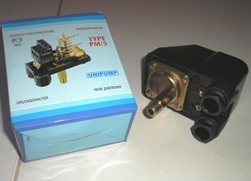Categories: Featured Articles » Home automation
Number of views: 90771
Comments on the article: 6
Pressure switch RM-5
 Water supply systems can be controlled and controlled according to various parameters - water level, pressure, temperature. The most common pressure control. One of the simplest and most popular elements of home automation in this case is the pressure switch RM-5.
Water supply systems can be controlled and controlled according to various parameters - water level, pressure, temperature. The most common pressure control. One of the simplest and most popular elements of home automation in this case is the pressure switch RM-5.
This relay is designed to control electric pumps to supply water to the house. Using the RM-5 relay, the pump will work clearly in the preset pressure mode. At minimum pressure, the contacts will close and the pump will turn on, and when the maximum pressure is reached, the contacts will open and the pump will turn off.
Pressure switch RM-5 is produced by different manufacturers. Because of this, such relays may have slight differences in the type of housing and the location of the cable connections.
There are varieties of pressure switches of this type with built-in pressure gauges, which simplifies their connection to the pump station, as the number of threaded connections is reduced. Relays are also available with a special lever that allows you to manually open the contacts if it cannot independently turn off the pump.
General view of the pressure switch RM-5 is shown in the figure. Now let's see how it works.

This is a two-contact relay for switching electrical circuits, which is triggered by the pressure of the water in the system. Inside its body are electrical contacts that are controlled by a membrane.
The pressure switch is most often connected to the pump station using a special five-piece adapter. In addition to the pressure switch, a pipe from a pump, a pipe from a water supply source, a hydraulic accumulator and a pressure gauge are connected to the adapter.
Read more in the article: How to connect a pump
The pump pumps water into the accumulator. According to the manometer, you can observe how the water pressure increases. The pressure switch automatically controls the on and off of the pump.
When connecting the relay to the adapter (connecting size 1/4 "), water presses on the membrane, which presses the springs controlling the electrical contacts. The relay contacts are connected in series with the pump motor and supply voltage to it.
The cable to the relay is connected through special sealed contacts. The operating voltage is 220 V. The relay itself has terminals marked “L” (Line), here they are connected to the electric cable, which comes from the mains. To terminals marked "M" (Motor) the cable from the pump motor is connected. There are also grounding contacts on the terminal block for connecting grounding cables.
When connecting a water pressure switch to the pump, it must be remembered that the maximum switched current of its contacts is 10A (for some models - 16A).

Relay contact wiring diagram
The principle of operation of the pressure switch RM-5 is very simple. If the pressure in the system drops below the switch-on level (1.4 bar or a preset value), then the contacts will close and the relay will turn on the pump, and if the pressure in the system will be higher than the switch-off level (2.8 bar or also a preset value) , the membrane presses on the springs, the contacts open and the pump switches off automatically. If the pressure drops below the set value, the process is repeated.
Thus, the RM-5 pressure switch is used to automatically maintain the water pressure in the water supply system in the operating range of 1.4 - 2.8 bar (factory pressure settings) or 1 - 5 bar (manual settings).
At the factory, these relays are configured according to existing standards and norms. Settings, as a rule, will not need to be changed, because they are the most optimal. Sometimes it becomes necessary to configure the relay to its own, different from the factory settings of operation.The desired result in the adjustment can be achieved by rotating the two clamping nuts in different directions.
To do this, remove the cover from the relay. In the case there are two nuts - large and small. Using a large nut, the pump shut-off pressure can be set. To increase the response threshold, twist it clockwise and check the pressure. Using the second nut, you can change the difference between the pressure on and off the pump both up and down.
All these settings must be made using a pressure gauge. After adjusting the relay, be sure to close the cover.
RM-5 pressure switch with integrated pressure gauge
The disadvantages of the RM-5 relay are that it has a rather complicated adjustment of pressure thresholds. In addition, the water pressure in the water supply system is maintained stepwise (the relay operates only on the lower and upper limits). If the water in the well or well has run out, it will not be able to turn off the pump. If there is no water, the relay will turn on until it can create pressure, which can lead to pump failure. Therefore, the RM-5 water pressure switch must be used together with the fluid flow switch to prevent the pump from running dry and breakage.
Read also on this topic:AQUAROBOT Turbipress - automatic pump control unit
See also at bgv.electricianexp.com
:

